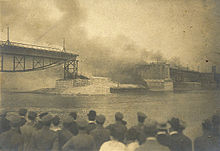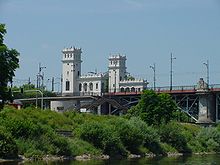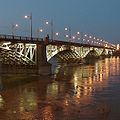- Poniatowski Bridge
-
Coordinates: 52°14′10″N 21°02′30″E / 52.23611°N 21.04167°E
Poniatowski Bridge (Polish: Most Poniatowskiego) is a bridge in Warsaw. Originally built between 1904 and 1914, it was damaged in each of the World Wars and rebuilt afterwards. It spans the Vistula, connecting Powiśle with the Praga quarter on the other side. Its viaduct is an extension of Aleje Jerozolimskie.
The 506 m long steel bridge, consisting of eight spans, was designed by Stefan Szyller. Its construction, started in 1904, was supervised by engineers Mieczysław Marszewski and Wacław Paszkowski. Despite being viewed by many as an extravagance (opponents of its construction included the then mayor of Warsaw and the writer Bolesław Prus), it was opened on January 6, 1914, by the Russian Governor General, Georgi Skalon, as Warsaw's third bridge; hence it was nicknamed "third bridge" (Polish: "trzeci most") by the city's residents, though its official name was "Bridge of Our Most Gracious Ruler, Tsar Nicholas II" (Warsaw then being part of the Russian Empire, following the 18th-century partitions of Poland). After Poland regained independence in 1918, the bridge was renamed after Prince Józef Poniatowski and acquired a new nickname — "Poniatoszczak" — which it retains to this day.
The bridge has suffered much during the World Wars. During the First World War, in 1915, the retreating Russian army blew up four of the spans, to slow down German pursuit. The bridge was hastily rebuilt by the Germans — only to burn down in an accident soon afterwards. After the war, the structure was rebuilt by the new Polish government over the course of five years, from 1921 to 1926. During the May Coup the bridge was the meeting place of the President of Poland, Stanisław Wojciechowski, and the leader of the coup, Marshal of Poland Józef Piłsudski. During the Second World War the bridge was destroyed by German troops during the Warsaw Uprising, on 13 September 1944. That demolition was much more complete: all spans were toppled, and only the lower piers survived.
The first plans by the new Polish government provided for the construction of a wooden temporary structure on the surviving pillars, but hasty work caused the bridge to collapse. Restored again on new pillars, the bridge was reopened again on 22 July 1946 by Bolesław Bierut. However, the reopened bridge lost much of its pre-war splendor, as limited funds meant that there were no resources to restore various non-functional neo-Polish renaissance decorations like hand-made balustrades or stone benches. Some of the old pre-war benches, as well as one of the old spans, can be seen in the water near the bridge at low water levels.
Between 1963 and 1966 the bridge was widened, a tram track was separated from the carriageway and the bridge was connected to the Wisłostrada expressway on the left bank of the Vistula by means of a long looping sloped roadway section which reminded some contemporary commentators of a snail's shell[1]. During another repair and expansion in 1985-1990, when the roads on the right bank (Praga) were expanded, a temporary bridge (Syrena Bridge) was erected (it was in use until replaced by Świętokrzyski Bridge in 2000).
In 2004 a reconstruction and beautification of the bridge began. By 2005 the small towers and the first four spans were rebuilt. The tram track repairs were carried out in 2007.
Contents
Gallery
References
- This article incorporates information from the revision as of 2 December 2006 of the equivalent article on the Polish Wikipedia.
- One Unlucky Bridge, Warsaw Voice, 1 July 2001
- ^ "News and views: Called "South snail" this unusual circuksar shaped approach road to the Poniatowski Bridge crossing the River Vistula recently came into operation in Warsaw...". Autocar vol 125 (nbr 3679): page 412. date 19 August 1966.
See also
- Łazienkowski Bridge
- Siekierkowski Bridge
- Świętokrzyski Bridge
External links
- Satellite view from Google Map
Categories:- Bridges completed in 1914
- Bridges in Warsaw
- Road bridges in Poland
Wikimedia Foundation. 2010.














